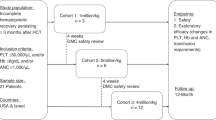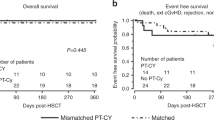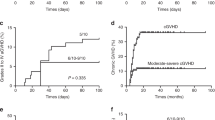Summary:
The lack of healthy HLA-identical sibs limits the use of allogeneic hematopoietic cell transplantation in children with high-risk sickle cell disease (SCD). We evaluated unrelated placental blood cell transplantation (UPBCT) after a preparative regimen of busulfan, cyclophosphamide and antithymocyte globulin in three children with SCD who had cerebrovascular accidents (CVAs) and did not have HLA-matched sib donors. The placental blood cell units were matched with the recipients at four of six HLA-A, HLA-B and HLA-DRB1 antigens. Neutrophil levels above 0.5 × 109/l occurred at 23, 38 and 42 days after UPBCT, and platelet levels above 50 × 109/l without transfusions occurred at 62, 81 and 121 days after UPBCT. All patients developed acute graft-versus-host disease (GVHD; two grade II, one grade III), and one developed extensive chronic GVHD. One patient had graft failure and autologous hematopoietic recovery. Two patients have complete donor hematopoietic chimerism without detectable hemoglobin S or symptoms of SCD at 40 and 61 months, respectively, after UPBCT. These observations demonstrate the feasibility of UPBCT in children with SCD. Further studies of UPBCT for SCD are needed but, because of risks of procedure-related morbidity and graft rejection, should be restricted to pediatric patients with high-risk manifestations of SCD.
This is a preview of subscription content, access via your institution
Access options
Subscribe to this journal
Receive 12 print issues and online access
$259.00 per year
only $21.58 per issue
Buy this article
- Purchase on Springer Link
- Instant access to full article PDF
Prices may be subject to local taxes which are calculated during checkout
Similar content being viewed by others
References
Fixler J, Styles L . Sickle cell disease. Pediatr Clin N Amer 2002; 49: 1193–1210.
Platt OS, Brambilla DJ, Rosse WF et al. Mortality in sickle cell disease. Life expectancy and risk factors for early death. N Engl J Med 1994; 330: 1639–1644.
Powars D, Wilson B, Imbus C et al. The natural history of stroke in sickle cell disease. Am J Med 1978; 65: 461–471.
Balkaran B, Char G, Morris JS et al. Stroke in a cohort of patients with homozygous sickle cell disease. J Pediatr 1992; 120: 360–366.
Ohene-Frempong K, Weiner SJ, Sleeper LA et al. Cerebrovascular accidents in sickle cell disease: rates and risk factors. Blood 1998; 91: 288–294.
Wang WC, Kovnar EH, Tonkin IL et al. High risk of recurrent stroke after discontinuance of five to twelve years of transfusion therapy in patients with sickle cell disease. J Pediatr 1991; 118: 377–382.
Pegelow CH, Adams RJ, McKie V et al. Risk of recurrent stroke in patients with sickle cell disease treated with erythrocyte transfusions. J Pediatr 1995; 26: 896–899.
Harmatz P, Butensky E, Quirolo K et al. Severity of iron overload in patients with sickle cell disease receiving chronic red blood cell transfusion therapy. Blood 2000; 96: 76–79.
Ballas SK . Iron overload is a determinant of morbidity and mortality in adult patients with sickle cell disease. Semin Hematol 2001; 38 (Suppl. 1): 30–36.
Vichinsky EP, Luban NL, Wright E et al. Prospective RBC phenotype matching in a stroke-prevention trial in sickle cell anemia: a multicenter transfusion trial. Transfusion 2001; 41: 1086–1092.
Rosse WF, Gallagher D, Kinney TR et al. Transfusion and alloimmunization in sickle cell disease. Blood 1990; 76: 1431–1437.
Vichinsky EP, Earles A, Johnson RA et al. Alloimmunization in sickle cell anemia and transfusion of racially unmatched blood. N Engl J Med 1990; 322: 1617–1621.
Bernaudin F, Souillet G, Vannier JP et al. Bone marrow transplantation (BMT) in 14 children with severe sickle cell disease (SCD): the French experience. Bone Marrow Transplant 1993; 12 (Suppl. 1): 118–121.
Vermylen C, Cornu G, Ferster A et al. Bone marrow transplantation in sickle cell disease: the Belgian experience. Bone Marrow Transplant 1993; 12 (Suppl. 1): 116–117.
Walters MC, Patience M, Leisenring W et al. Bone marrow transplantation for sickle cell disease. N Engl J Med 1996; 335: 369–376.
Abboud MR, Kletzel M, Miller S et al. Bone marrow transplantation for sickle cell disease (abstract). Blood 1997; 90: 229a.
Bernaudin F, Souillet G, Vannier JP et al. Report of the French experience concerning 26 children transplanted for severe sickle cell disease. Bone Marrow Transplant 1997; 19 (Suppl. 2): 112–115.
Vermylen C, Cornu G, Ferster A et al. Haematopoietic stem cell transplantation for sickle cell anaemia: the first 50 patients transplanted in Belgium. Bone Marrow Transplant 1998; 22: 1–6.
Walters MC, Storb R, Patience M et al. Impact of bone marrow transplantation for symptomatic sickle cell disease: an interim report. Blood 2000; 95: 1918–1924.
Vichinsky EP, Neumayr LD, Earles AN et al. Causes and outcomes of the acute chest syndrome in sickle cell disease. N Engl J Med 2000; 342: 1855–1865.
Locatelli F, Rocha V, Reed W et al. Related umbilical cord blood transplantation in patients with thalassemia and sickle cell disease. Blood 2003; 101: 2137–2143.
Walters MC, Patience M, Leisenring W et al. Barriers to bone marrow transplantation for sickle cell anemia. Biol Blood Marrow Transplant 1996; 2: 100–104.
Walters MC, Patience M, Leisenring W et al. Collaborative multicenter investigation of marrow transplantation for sickle cell disease: current results and future directions. Biol Blood Marrow Transplant 1997; 3: 310–315.
Kurtzberg J, Laughlin M, Graham ML et al. Placental blood as a source of hematopoietic stem cells for transplantation into unrelated recipients. N Engl J Med 1996; 335: 157–166.
Gluckman E, Rocha V, Boyer-Chammard A et al. Outcome of cord-blood transplantation from related and unrelated donors. N Engl J Med 1997; 337: 373–381.
Rubinstein P, Carrier C, Scaradavou A et al. Outcomes among 562 recipients of placental-blood transplants from unrelated donors. N Engl J Med 1998; 339: 1565–1577.
Rocha V, Wagner Jr JE, Sobocinski KA et al. Graft-versus-host disease in children who have received a cord-blood or bone marrow transplant from an HLA-identical sibling. N Engl J Med 2000; 342: 1846–1854.
Laughlin MJ, Barker J, Bambach B et al. Hematopoietic engraftment and survival in adult recipients of umbilical-cord blood from unrelated donors. N Engl J Med 2001; 344: 1815–1822.
Rocha V, Cornish J, Sievers EL et al. Comparison of outcomes of unrelated bone marrow and umbilical cord blood transplants in children with acute leukemia. Blood 2001; 97: 2962–2971.
Barker JN, Davies SM, DeFor TE et al. Survival after transplantation of unrelated donor umbilical cord blood is comparable to that of human leukocyte antigen-matched unrelated donor bone marrow: results of a matched-pair analysis. Blood 2001; 97: 2957–2961.
Wagner JE, Barker JN, DeFor TE et al. Transplantation of unrelated donor umbilical cord blood in 102 patients with malignant and nonmalignant diseases: influence of CD34 cell dose and HLA disparity on treatment-related mortality and survival. Blood 2002; 100: 1611–1618.
Grewal SS, Barker JN, Davies SM, Wagner JE . Unrelated donor hematopoietic cell transplantation: marrow or umbilical cord blood? Blood 2003; 101: 4233–4244.
Adamkiewicz TV, Hsu LL, Rubinstein P et al. Feasibility of identification of unrelated placental/umbilical cord blood cell units for transplantation in patients with high-risk sickle cell disease. Blood 1998; 92: 162a (abstract).
Krishnamurti L, Abel S, Maiers M, Flesch S . Availability of unrelated donors for hematopoietic stem cell transplantation for hemoglobinopathies. Bone Marrow Transplant 2003; 31: 547–550.
Marcus RE, Goldman JM . Convulsions due to high-dose busulfan. Lancet 1984; 2: 1463.
Rubinstein P, Dobrila L, Rosenfield RE et al. Processing and cryopreservation of placental/umbilical cord blood for unrelated bone marrow reconstitution. Proc Natl Acad Sci USA 1995; 92: 10119–10122.
Scharf SJ, Smith AG, Hansen JA et al. Quantitative determination of bone marrow transplant engraftment using fluorescent polymerase chain reaction primers for human identity markers. Blood 1995; 85: 1954–1963.
Przepiorka D, Weisdorf D, Martin P et al. Consensus conference on acute GVHD grading. Bone Marrow Transplant 1995; 15: 825–828.
Sullivan KM, Agura E, Anasetti C et al. Chronic graft-versus-host disease and other late complications of bone marrow transplantation. Semin Hematol 1991; 28: 250–259.
Lansky SB, List MA, Lansky LL et al. The measurement of performance in childhood cancer patients. Cancer 1987; 60: 1651–1656.
Beatty PG, Boucher KM, Mori M, Milford EL . Probability of finding HLA-mismatched related or unrelated marrow or cord blood donors. Human Immunol 2000; 61: 834–840.
Scothorn DJ, Price C, Schwartz D et al. Risk of recurrent stroke in children with sickle cell disease receiving blood transfusion therapy for at least five years after initial stroke. J Pediatr 2002; 140: 348–354.
Ware RE, Zimmerman SA, Schultz WH . Hydroxyurea as an alternative to blood transfusions for the prevention of recurrent stroke in children with sickle cell disease. Blood 1999; 94: 3022–3026.
Steen RG, Helton KJ, Horwitz EM et al. Improved cerebrovascular patency following therapy in patients with sickle cell disease: initial results in 4 patients who received HLA-identical hematopoietic stem cell allografts. Ann Neurol 2001; 49: 222–229.
Adamkiewicz TV, Chiang KY, Haight A et al. Significant progression of large central nervous system (CNS) vessel disease following full matched sibling marrow engraftment in a child with Hg SS, National Sickle Cell Disease Program 25th Annual Meeting 2002; Vol. 1 (abstract).
Kalinyak KA, Morris C, Ball WS et al. Bone marrow transplantation in a young child with sickle cell anemia. Am J Hematol 1995; 48: 256–261.
Anasetti C, Amos D, Beatty PG et al. Effect of HLA compatibility on engraftment of bone marrow transplants in patients with leukemia or lymphoma. N Engl J Med 1989; 320: 197–204.
Charache S, Terrin ML, Moore RD et al. Effect of hydroxyurea on the frequency of painful crises in sickle cell anemia. N Engl J Med 1995; 332: 1317–1322.
Steinberg MH, Barton F, Castro O et al. Effect of hydroxyurea on mortality and morbidity in adult sickle cell anemia: risks and benefits up to 9 years of treatment. JAMA 2003; 289: 1645–1651.
Vichinsky EP . Current issues with blood transfusions in sickle cell disease. Semin Hematol 2001; 38: 14–22.
Nisbet-Brown E, Olivieri NF, Giardina PJ et al. Effectiveness and safety of ICL670 in iron-loaded patients with thalassaemia: a randomised, double-blind, placebo-controlled, dose-escalation trial. Lancet 2003; 361: 1597–1602.
Acknowledgements
This study was supported by grants from the National Institutes of Health, Bethesda, MD (K23 HL04251) (TVA), (R01 CA40282 and U10 CA20549) (AMY), and by grants from the Emory Medical Care Foundation (TVA), the Phil Niekro Egleston Celebrity Classic/Jill Andrews Leukemia Research Fund (AMY), the Andrew McLeroy Memorial Research Fund (AMY), the Armstead-Barnhill Foundation for Sickle Cell Anemia Research (AMY) and the Stott Research Fund in Honor of Alex Jensen (AMY).
Author information
Authors and Affiliations
Corresponding author
Rights and permissions
About this article
Cite this article
Adamkiewicz, T., Mehta, P., Boyer, M. et al. Transplantation of unrelated placental blood cells in children with high-risk sickle cell disease. Bone Marrow Transplant 34, 405–411 (2004). https://doi.org/10.1038/sj.bmt.1704606
Received:
Accepted:
Published:
Issue Date:
DOI: https://doi.org/10.1038/sj.bmt.1704606
Keywords
This article is cited by
-
Has stem cell transplantation come of age in the treatment of sickle cell disease?
Bone Marrow Transplantation (2007)



